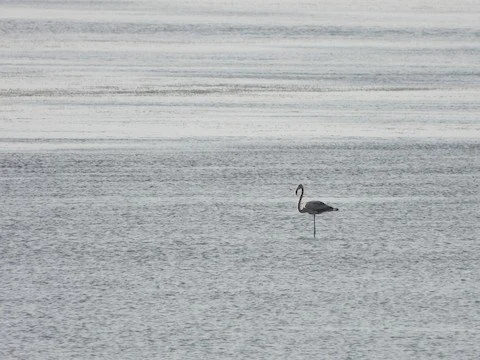On Saturday, December 9, nineteen birders joined TAS field trip leader Luis Gonzalez for a full day of birding in Everglades National Park. The trip began at the end of the main park road in Flamingo and ended at the Lucky Hammock area, just outside the park’s entrance. This “backwards” itinerary, which requires a drive of an additional 38 miles to reach the trip starting point, allowed us to bird the Flamingo area first thing in the morning, rather than late in the afternoon, as we typically do on all other TAS trips to the national park. On this particular day, that strategy, which requires participants to leave home at least 45 minutes earlier, paid immediate dividends.
Birding began on the breezeway at the newly renovated visitor center, which provides an elevated vantage point for viewing mudflats on Florida Bay that are exposed only at low tide. Luis chose this particular date for the trip because low tide was early in the morning. The area was teeming with birds, so we spent more than an hour here. Species seen during this first stop included White-crowned Pigeon, Black-bellied, Semipalmated and Wilson’s Plovers, Marbled Godwit, Short-billed Dowitcher, Dunlin, Willet, Laughing Gull, Black Skimmer, Caspian and Royal Terns, Double-crested Cormorant, American White and Brown Pelicans, Black-crowned Night Heron, Little Blue, Tricolored and Great Blue Herons (including white morph Great Blues), Reddish, Snowy and Great Egrets, White Ibis, Osprey and Belted Kingfisher.
Just as we were about to move on, Andrea Diamond suddenly yelled “flamingo!” Sure enough, mixed in with all the birds out on the distant mudflats was an immature American Flamingo! Almost certainly, this bird was part of the large flock of flamingos that has made Florida Bay its home since arriving in the area in late August after the passage of Hurricane Idalia. While most of the flock can only be seen by paddling out to the Snake Bight area east of Flamingo, some of the birds occasionally wander to spots closer to Flamingo, where they can be enjoyed by those on boat tours of the bay, or for us, right from the visitor center!
We made a couple of other stops in the Flamingo area before heading north to explore other areas within the park. At the campground amphitheater area, we found an Osprey on a nest, two Bald Eagles flying overhead (an adult and an immature bird), a perched Peregrine Falcon, as well as Spotted Sandpiper, Lesser Yellowlegs, Yellow-crowned Night Heron, Red-shouldered Hawk, Red-bellied Woodpecker, American Kestrel, American Crow, House Wren and Savannah Sparrow. At Eco Pond, we found lots of mosquitoes but not much else. At the marina, we found several West Indian Manatees but no American Crocodiles. A flock of wading birds that included 40 Wood Storks was found in a flooded area along the road shortly after leaving Flamingo.
While exploring the boardwalk at West Lake, we spotted a Short-tailed Hawk overhead and heard a couple of singing White-eyed Vireos. At Mahogany Hammock, we found Eastern Phoebe, White-eyed Vireo, American Redstart, Northern Parula and Black-and-white, Magnolia, Palm, Pine, Prairie and Black-throated Green Warblers. At Long Pine Key, where we had lunch, we saw Downy Woodpecker, Brown-headed Nuthatch, Eastern Towhee and Yellow-throated Warbler. At Anhinga Trail, our final stop within the park, we found Purple Gallinule, Anhinga, Double-crested Cormorant, Least Bittern (heard), Western Cattle Egret, Great Egret, Great Blue Heron, Eastern Phoebe, Northern Rough-winged Swallow, Gray Catbird, Common Yellowthroat and Black-and-white and Yellow-rumped Warblers.
Leaving the park, we made a brief stop at the Lucky Hammock parking area on Aerojet Road, hoping to see a Vermilion Flycatcher and other rarities that have been wintering in this area, but we only added Loggerhead Shrike and Eastern Meadowlark to our trip list. Hearing that another rarity, a Yellow-headed Blackbird, was being seen a half-mile away along the C-111 Canal, we decided to go for that instead (one participant went back later and found the Vermilion Flycatcher). At the C-111, we drove north to a spot along the canal where a large flock of Red-winged Blackbirds had assembled on the electrical wires. Among them was the Yellow-headed Blackbird, along with Brown-headed and Bronzed Cowbirds. A Brewer’s Blackbird, a bird rarely seen in south Florida, was also photographed in that flock, but we didn’t find out about that rarity until the following day.
An eBird trip report, listing the 80 species tallied during the day and including checklists for each stop, can be viewed here.
American Flamingo: Photo by Luis Gonzalez

